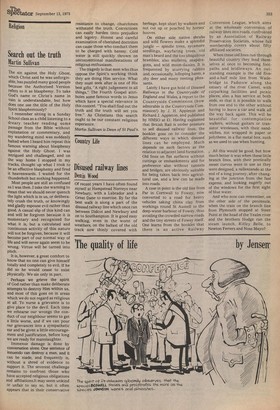Country Life
Disused railway lines
Denis Wood
Of recent years I have often found myself at Hampstead Norreys near Newbury, with a Labrador and a Great Dane to exercise. By far the best walk is along a part of the disused railway line which once ran between Didcot and Newbury and on to Southampton. It is good easy walking, even in the worst of weathers, on the ballast of the old track now thinly covered with herbage, kept short by walkers and not cut up or poached by horses' hooves.
On either side native shrubs and wild flowers Make a splendid jungle — spindle trees, sycamore seedlings, wayfaring trees, old man's beard and the too ubiquitous brambles; also mulleins, snapdragons, and wild moon-daisies. It is frequented by scurrying rabbits and, occasionally, lolloping hares, a shy deer and many nesting pheasants.
Lately I have got hold of Disused Railways in the Countryside of England and Wales, a report to the Countryside Commission (how admirable is the Countryside Commission!) by J. H. Appleton and Richard J. Appleton, and published by HMSO at EL Having explained that British Rail is under pressure to sell disused railway lines, the booklet goes on to consider the different ways in which disused lines can be employed. Much depends on such factors as the relation to adjacent land formation. Old lines on flat surfaces without cuttings or embankments and for preference also without tunnels and bridges, are obviously suitable for being taken back into agricultural use, and a few can be made into roads.
A case in point is the old line from Par in Cornwall to Fovvey, now converted to a road for heavy vehicles taking china clay from workings round St Austell to the deep-water harbour of Fowey, thus avoiding the crowded narrow roads and the tiny streets of Fowey itself. One learns from the booklet that there is an active Railway Conversion League, which aims at the wholesale conversion of railway lines into roads, confronted by an Association of Railway Preservation Societies, whose full membership covers about fifty affiliated societies.
When these old lines run through beautiful country they lend themselves at once to becoming footpaths and bridleways. An outstanding example is the old fiveand-a-half mile line from Wadebridge to Padstow along the estuary of the river Camel, with carparking facilities and picnic places; also a bus service at both ends, so that it is possible to walk from one end to the other without having to leave a car and walk all the way back again. This will be beautiful for contemplative walkers, without guitars or transistor wirelesses, with their sandwiches, not wrapped in paper or polythene, in a flat metal box, such as we used to use when hunting.
t All this would be good, but how much better it was when these little branch lines, with their poetically sweet curves were in use as they were designed, a railentando at the end of a long journey, after changing at the junction from the fast express, and looking eagerly out of the windows for the first sight of blue water.
And who now can remember, on the other side of the peninsula, when the train on the branch line from Plymouth stopped at Steer Point at the head of the Yea1m river and the brothers Hodge ran the steam launch, Kitley Belle, to Newton Ferrers and Noss Mayo?


































 Previous page
Previous page